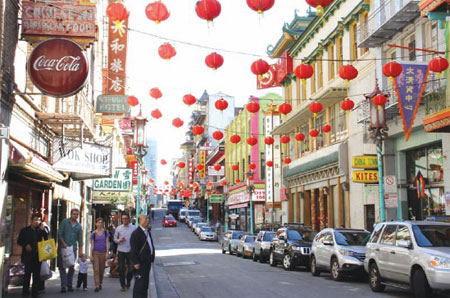Who's got the No 1 Chinatown in the US?
|
A colorful block in San Francisco's Chinatown, ranked in a new USA Today survey as the best of its kind in the US. The survey looked at "quality of authentic dining options" and "cultural experiences available", among other amenities. Bonnie Wong / China Daily |
From the oldest San Francisco Chinatown to those smaller but just-as-bustling ones across the United States, more and more American travelers are putting them high on their list of places to go.
The 165-year-old San Francisco Chinatown has just been crowned No 1 by a new USA Today poll among the 10 best Chinatowns across the country, followed by New York City, Chicago, Seattle andPhiladelphia.
Chinatowns in Honolulu, Boston, Los Angeles, Houston and Washington DC were among the top six to10.
USA Today did the ranking in terms of "quality of authentic dining options", "size" and "cultural experiences available". The most unique criteria of the ranking was "whether a visitor will feel like they've left the United States as they explore the neighborhood".
"Walking around this vibrant and densely populated area that still retains its ethnic identity, sometimes may you forget where you are," said Maurice Edelstein, an 82-year-old photographer who lives in San Francisco and over the years has walked through this historic neighborhood taking pictures that capture the area's rich, colorful environment.
"Visitors won't be disappointed by the pictures before them: fish markets, restaurants, early generation Chinese immigrants and their offspring who are still living here and displaying their daily stories," he said.
Located near the Financial District and Little Italy on north shore, the narrow streets of San Francisco Chinatown cover more than 20 square blocks filled with small businesses, restaurants, school and hospital. Some Chinese immigrants who are unable to speak English never walk out of this region for their whole lives.
San Francisco's city officials have come to value the culinary aspect of Chinatownand its economic footprint in recent years.
At the end of last year, Mayor Ed Lee announced a new neighborhood investment plan for Asian communities, including Chinatown. He made the decision because some Chinatown merchants complained about the disruption in customer traffic and loss of business caused by the city's subway construction projects.
"I agree SF Chinatown is No1 because the residents here are mainly recent immigrants who actually live in the community and brought with them the intact culture from the villages where they are from," said WilmaPang, a community leader inChinatown.
As a child, Pang grew up in Melbourne, Australia and moved to Honolulu in her teens.She has been to many Chinatowns around the world, and said there is nothing like SF Chinatown.
"SF in unique because it is a community where one can live without speaking any English. There is a Chinese Hospital and a mortuary. So, literally one can be born and die here without venturing out to other parts of the city," she said.
She has been living in the heart of SF Chinatown for 35 years and learned to speak fluent Cantonese there.
"My fear is that gentrification is inevitable because of the rapid expansion of developers eyeingthe valuable properties so close and convenient to downtown," she said.
Some people said today's Chinatown has long lost its distinction as the enclave or ghetto where one had to go for delicious Chinese cuisine.
"In the Bay Area, excellent Chinese restaurants are everywhere, most of the good ones are not even in San Francisco, much less in the Chinatown," said George Koo, a local resident.
chenjia@chinadailyusa.com



















